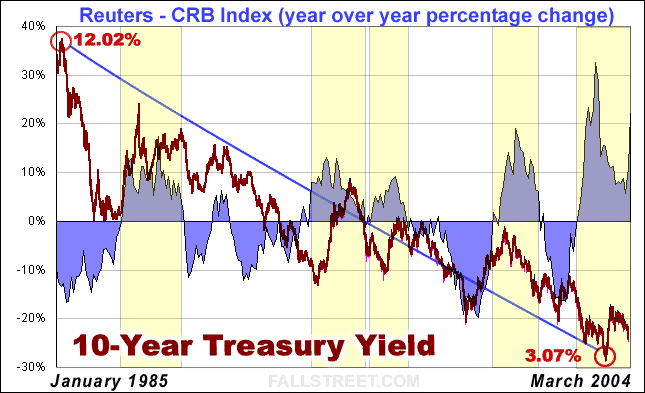April 21, 2004
Today’s Word is Inflation
By Brady Willett
 Greenspan’s neighborhood is not made up of certainties. Rather, the intentions of central bankers is to try and sculpt financial realities. As the word ‘inflation’ rears its ugly head, Mr. Greenspan sings a Mr. Rogers lullaby:
Greenspan’s neighborhood is not made up of certainties. Rather, the intentions of central bankers is to try and sculpt financial realities. As the word ‘inflation’ rears its ugly head, Mr. Greenspan sings a Mr. Rogers lullaby:
It's a beautiful day in this neighborhood,
A beautiful day for a neighbor.
Would you be mine?
Could you be mine?...
Won't you be my neighbor?
As if to comment on that which is blatantly obvious, Mr. Greenspan stated yesterday that the threat of deflation is no more:
”Threats of deflation, which were a significant concern last year, by all indications are no longer an issue before us”
Mr. Greenspan’s words carry with them a comedic tone. After all, equity and home prices have boomed during the last year, commodity prices have been zooming ahead as other engines of growth besides America emerge (China), and even the US governments’ take on inflation (CPI) has been perky in 2004. Suffice to say, Mr. Greenspan saying that the threat of deflation is dead isn’t noteworthy. Rather, the suggestion that the Fed finally recognizes that inflation is alive is.
Recap: Understanding Fed Intent
In Mr. Greenspan’s neighborhood no one aspires to comment on reality. Rather, trying to influence a future reality is the most enviable of pursuits. Such is why in 2003 and early 2004 Fed member after Fed member argued that interest rates could remain low for a considerable period of time even as the US economy grew strongly, asset prices skyrocketed, and government deficits mushroomed – or because the Fed wanted to pattern the financial markets as they deemed fit. Had the Fed been more fearful of the potentially negative consequences of a zero bound interest rate policy, or warned of popping asset bubbles rather than deflationary ghosts, a different reality might have unfolded. Indeed, had the Fed not promised countless times to remain accommodative, interest rates might not have stayed so low for so long.
For some, the Fed flat out lied: deflation can not be a threat so long as the Fed can freely print dollars. Yet to others the Fed provided the assurances needed to keep the financial markets rolling: reflation trades can only be held onto so long as the Fed is promising to stay on hold. Regardless, Fed rhetoric since 2003 (perhaps also direct financial market intervention by the Fed) has worked wonders. The Fed wanted rates to remain low – they did. The Fed wanted a weaker greenback to help bring inflation (pricing power) back into the economy - it did.
 |
As the above chart aptly demonstrates, the year on year increase in the CRB has been both strong and long since 2003. With this in mind, what was considered an impossibility 20-years ago has become a reality today: as commodity prices surged during the last year interest rates actually declined.
What Comes Next
Assuming the Fed is serious about reacquiring some monetary ammo and/or beating back inflationary forces, Greenspan and company must now lay the groundwork for some interest rate hikes. Historically – the post Asian crisis in mind - Greenspan has not been shy about hiking interest rates under the guise of ‘taking back’ some of the Fed’s previous cuts. This tactic would work today so long the hot US housing market doesn’t implode, stocks do not crash, and foreign interest in government bonds doesn’t suddenly evaporate (sending T-yields sharply higher). Yes, with these threats in mind – threats the Fed’s anti-deflationary flight helped make more ominous - what comes next is a lot of uncertainty.
Market Reaction To Greenspan’s Words
Precious metals have been feeding off of the weakening dollar for some time. Moreover, speculators have been supporting gold/silver even as the commercials padded their net short positions. With this in mind, the jig - which will probably never be up baring a US dollar calamity – has not proven to be up, and silver continued its violent descent following Greenspan’s comments. Reacting to the stronger dollar gold has also crashed back below the $400 an ounce level. Wipeouts of the variety now being witnessed in precious metals - although the route in silver was one of the most dramatic in decades - are commonplace after run-ups.
Incidentally, the suggestion that I made to sell some silver earlier this month was not prescient. Rather, even though I did trim my silver stake earlier this month, I still own gold/silver for long-term today.
Stocks declined modestly following Greenspan and, after bonds were scared lower, the yield on the 10-year is zeroing in on yearly highs. That overvalued stocks declined in the face of strong quarterly earnings reports is irrelevant. Remember, inflation is the buzz word.
Conclusion
Although ‘artificially’ influencing long-term interest rates lower may, eventually, have a deleterious impact on the financial markets, the fact remains that by warning of deflation the Fed found a new tool by which to craft monetary policy. In other words, as the Fed ran out of rate cut ammo they loaded up on rhetoric: ‘buy stocks and bonds because interest rates are so low and interest rates are going to stay low!’
Even so, warning of the threat of deflation is not the same as warning of inflation. To be sure, after promising to keep